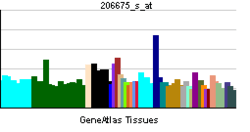SKIL
Ski-like protein is a protein that in humans is encoded by the SKIL gene.[1][2]
Interactions
SKIL has been shown to interact with SKI protein,[3] Mothers against decapentaplegic homolog 3[4][5] and Mothers against decapentaplegic homolog 2.[4][5]
References
- ↑ Nomura N, Sasamoto S, Ishii S, Date T, Matsui M, Ishizaki R (September 1989). "Isolation of human cDNA clones of ski and the ski-related gene, sno". Nucleic Acids Res 17 (14): 5489–500. doi:10.1093/nar/17.14.5489. PMC 318172. PMID 2762147.
- ↑ "Entrez Gene: SKIL SKI-like oncogene".
- ↑ Cohen, S B; Zheng G; Heyman H C; Stavnezer E (February 1999). "Heterodimers of the SnoN and Ski oncoproteins form preferentially over homodimers and are more potent transforming agents". Nucleic Acids Res. (ENGLAND) 27 (4): 1006–14. doi:10.1093/nar/27.4.1006. ISSN 0305-1048. PMC 148280. PMID 9927733.
- ↑ 4.0 4.1 Stroschein, S L; Bonni S; Wrana J L; Luo K (November 2001). "Smad3 recruits the anaphase-promoting complex for ubiquitination and degradation of SnoN". Genes Dev. (United States) 15 (21): 2822–36. doi:10.1101/gad.912901. ISSN 0890-9369. PMC 312804. PMID 11691834.
- ↑ 5.0 5.1 Stroschein, S L; Wang W; Zhou S; Zhou Q; Luo K (October 1999). "Negative feedback regulation of TGF-beta signaling by the SnoN oncoprotein". Science (UNITED STATES) 286 (5440): 771–4. doi:10.1126/science.286.5440.771. ISSN 0036-8075. PMID 10531062.
Further reading
- Pearson-White S (1993). "SnoI, a novel alternatively spliced isoform of the ski protooncogene homolog, sno". Nucleic Acids Res. 21 (19): 4632–8. doi:10.1093/nar/21.19.4632. PMC 311202. PMID 8233802.
- Pearson-White S, Crittenden R (1997). "Proto-oncogene Sno expression, alternative isoforms and immediate early serum response". Nucleic Acids Res. 25 (14): 2930–7. doi:10.1093/nar/25.14.2930. PMC 146803. PMID 9207045.
- Cohen SB, Zheng G, Heyman HC, Stavnezer E (1999). "Heterodimers of the SnoN and Ski oncoproteins form preferentially over homodimers and are more potent transforming agents". Nucleic Acids Res. 27 (4): 1006–14. doi:10.1093/nar/27.4.1006. PMC 148280. PMID 9927733.
- Stroschein SL, Wang W, Zhou S et al. (1999). "Negative feedback regulation of TGF-beta signaling by the SnoN oncoprotein". Science 286 (5440): 771–4. doi:10.1126/science.286.5440.771. PMID 10531062.
- Bonni S, Wang HR, Causing CG et al. (2001). "TGF-beta induces assembly of a Smad2-Smurf2 ubiquitin ligase complex that targets SnoN for degradation". Nat. Cell Biol. 3 (6): 587–95. doi:10.1038/35078562. PMID 11389444.
- Imoto I, Pimkhaokham A, Fukuda Y et al. (2001). "SNO is a probable target for gene amplification at 3q26 in squamous-cell carcinomas of the esophagus". Biochem. Biophys. Res. Commun. 286 (3): 559–65. doi:10.1006/bbrc.2001.5428. PMID 11511096.
- Stroschein SL, Bonni S, Wrana JL, Luo K (2001). "Smad3 recruits the anaphase-promoting complex for ubiquitination and degradation of SnoN". Genes Dev. 15 (21): 2822–36. doi:10.1101/gad.912901. PMC 312804. PMID 11691834.
- Mizuide M, Hara T, Furuya T et al. (2003). "Two short segments of Smad3 are important for specific interaction of Smad3 with c-Ski and SnoN". J. Biol. Chem. 278 (1): 531–6. doi:10.1074/jbc.C200596200. PMID 12426322.
- Strausberg RL, Feingold EA, Grouse LH et al. (2003). "Generation and initial analysis of more than 15,000 full-length human and mouse cDNA sequences". Proc. Natl. Acad. Sci. U.S.A. 99 (26): 16899–903. doi:10.1073/pnas.242603899. PMC 139241. PMID 12477932.
- Tomsig JL, Snyder SL, Creutz CE (2003). "Identification of targets for calcium signaling through the copine family of proteins. Characterization of a coiled-coil copine-binding motif". J. Biol. Chem. 278 (12): 10048–54. doi:10.1074/jbc.M212632200. PMID 12522145.
- He J, Tegen SB, Krawitz AR et al. (2003). "The transforming activity of Ski and SnoN is dependent on their ability to repress the activity of Smad proteins". J. Biol. Chem. 278 (33): 30540–7. doi:10.1074/jbc.M304016200. PMID 12764135.
- Colland F, Jacq X, Trouplin V et al. (2004). "Functional Proteomics Mapping of a Human Signaling Pathway". Genome Res. 14 (7): 1324–32. doi:10.1101/gr.2334104. PMC 442148. PMID 15231748.
- Gerhard DS, Wagner L, Feingold EA et al. (2004). "The Status, Quality, and Expansion of the NIH Full-Length cDNA Project: The Mammalian Gene Collection (MGC)". Genome Res. 14 (10B): 2121–7. doi:10.1101/gr.2596504. PMC 528928. PMID 15489334.
- Sarker KP, Wilson SM, Bonni S (2005). "SnoN is a cell type-specific mediator of transforming growth factor-beta responses". J. Biol. Chem. 280 (13): 13037–46. doi:10.1074/jbc.M409367200. PMID 15677458.
- Barrios-Rodiles M, Brown KR, Ozdamar B et al. (2005). "High-throughput mapping of a dynamic signaling network in mammalian cells". Science 307 (5715): 1621–5. doi:10.1126/science.1105776. PMID 15761153.
- Poser I, Rothhammer T, Dooley S et al. (2005). "Characterization of Sno expression in malignant melanoma". Int. J. Oncol. 26 (5): 1411–7. doi:10.3892/ijo.26.5.1411. PMID 15809735.
- Krakowski AR, Laboureau J, Mauviel A et al. (2005). "Cytoplasmic SnoN in normal tissues and nonmalignant cells antagonizes TGF-β signaling by sequestration of the Smad proteins". Proc. Natl. Acad. Sci. U.S.A. 102 (35): 12437–42. doi:10.1073/pnas.0504107102. PMC 1194926. PMID 16109768.
- Zhu Q, Pearson-White S, Luo K (2006). "Requirement for the SnoN Oncoprotein in Transforming Growth Factor β-Induced Oncogenic Transformation of Fibroblast Cells". Mol. Cell. Biol. 25 (24): 10731–44. doi:10.1128/MCB.25.24.10731-10744.2005. PMC 1316959. PMID 16314499.
- Briones-Orta MA, Sosa-Garrocho M, Moreno-Alvarez P et al. (2006). "SnoN co-repressor binds and represses smad7 gene promoter". Biochem. Biophys. Res. Commun. 341 (3): 889–94. doi:10.1016/j.bbrc.2006.01.041. PMID 16442497.
